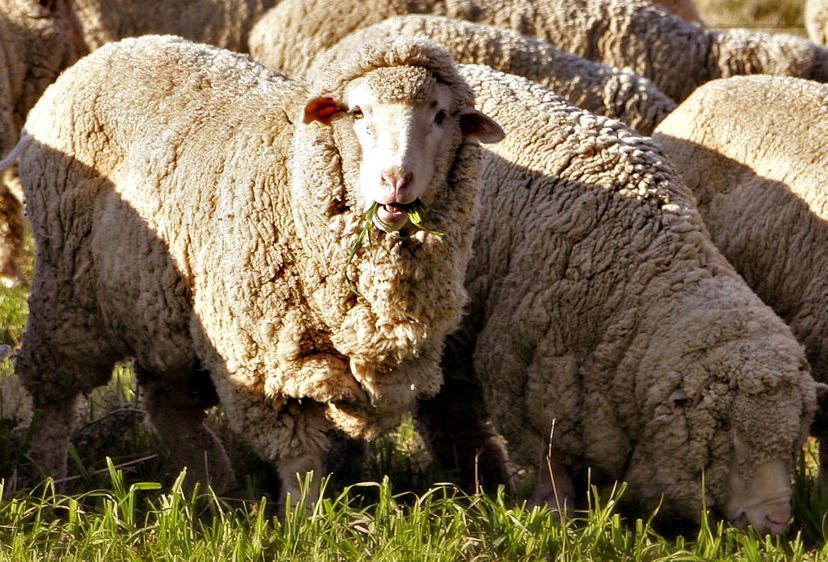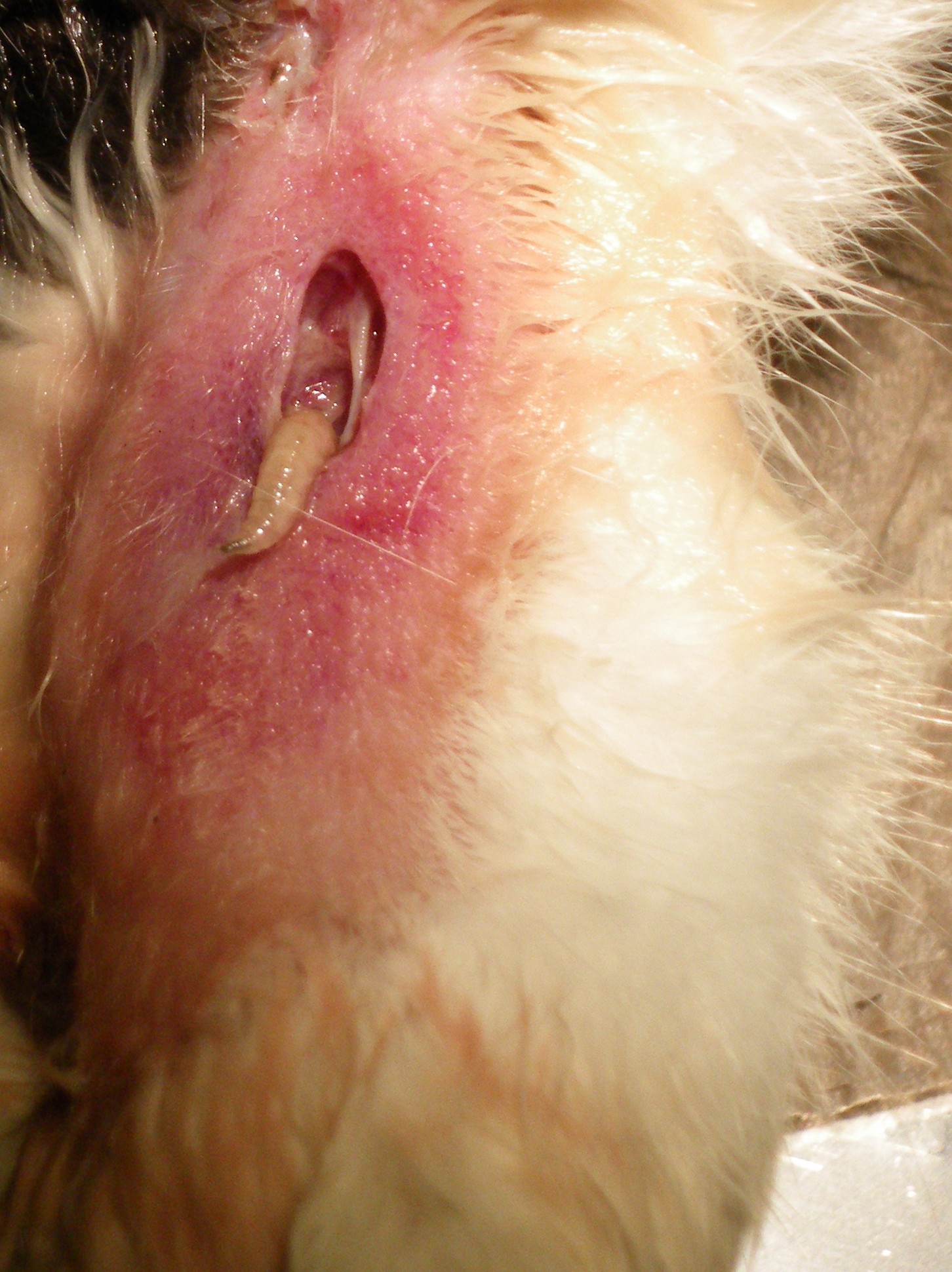|
Finnsheep
The Finnish Landrace, Finn or Finnsheep is a breed of domestic sheep native to Finland. It is one of several Northern European short-tailed sheep breeds, but is notable for its high incidence of multiple births – it is common for a ewe to have three, four, or even five lambs at once. The lambs are often small, but are vigorous at birth and grow well. The lambs mature early and can be mated at six months of age. Ewes commonly breed out of season and some may lamb twice in a year. The breed belongs to the group of Northern European short-tailed sheep, which also includes Shetland, Icelandic, Romanov, Spaelsau, and several other breeds. The Finnsheep is often used in crossbreeding programs to increase lambing percentage, and Finnsheep blood is found in many of the newer breeds. Characteristics Wool The fineness of Finnsheep wool has some individual variation, but the American Sheep Industry’s Wool Council ranks Finnsheep in the fine end of the medium wool category.'' ... [...More Info...] [...Related Items...] OR: [Wikipedia] [Google] [Baidu] |
Finnsheep Ewe Being Shorn By Hand
The Finnish Landrace, Finn or Finnsheep is a breed of domestic sheep native to Finland. It is one of several Northern European short-tailed sheep breeds, but is notable for its high incidence of multiple births – it is common for a ewe to have three, four, or even five lambs at once. The lambs are often small, but are vigorous at birth and grow well. The lambs mature early and can be mated at six months of age. Ewes commonly breed out of season and some may lamb twice in a year. The breed belongs to the group of Northern European short-tailed sheep, which also includes Shetland, Icelandic, Romanov, Spaelsau, and several other breeds. The Finnsheep is often used in crossbreeding programs to increase lambing percentage, and Finnsheep blood is found in many of the newer breeds. Characteristics Wool The fineness of Finnsheep wool has some individual variation, but the American Sheep Industry’s Wool Council ranks Finnsheep in the fine end of the medium wool category.'' ... [...More Info...] [...Related Items...] OR: [Wikipedia] [Google] [Baidu] |
Finnsheep Ram Lamb Fleece
The Finnish Landrace, Finn or Finnsheep is a breed of domestic sheep native to Finland. It is one of several Northern European short-tailed sheep breeds, but is notable for its high incidence of multiple births – it is common for a ewe to have three, four, or even five lambs at once. The lambs are often small, but are vigorous at birth and grow well. The lambs mature early and can be mated at six months of age. Ewes commonly breed out of season and some may lamb twice in a year. The breed belongs to the group of Northern European short-tailed sheep, which also includes Shetland, Icelandic, Romanov, Spaelsau, and several other breeds. The Finnsheep is often used in crossbreeding programs to increase lambing percentage, and Finnsheep blood is found in many of the newer breeds. Characteristics Wool The fineness of Finnsheep wool has some individual variation, but the American Sheep Industry’s Wool Council ranks Finnsheep in the fine end of the medium wool category.'' ... [...More Info...] [...Related Items...] OR: [Wikipedia] [Google] [Baidu] |
Finnsheep Ewes And Lambs, Finland
The Finnish Landrace, Finn or Finnsheep is a breed of domestic sheep native to Finland. It is one of several Northern European short-tailed sheep breeds, but is notable for its high incidence of multiple births – it is common for a ewe to have three, four, or even five lambs at once. The lambs are often small, but are vigorous at birth and grow well. The lambs mature early and can be mated at six months of age. Ewes commonly breed out of season and some may lamb twice in a year. The breed belongs to the group of Northern European short-tailed sheep, which also includes Shetland, Icelandic, Romanov, Spaelsau, and several other breeds. The Finnsheep is often used in crossbreeding programs to increase lambing percentage, and Finnsheep blood is found in many of the newer breeds. Characteristics Wool The fineness of Finnsheep wool has some individual variation, but the American Sheep Industry’s Wool Council ranks Finnsheep in the fine end of the medium wool category.'' ... [...More Info...] [...Related Items...] OR: [Wikipedia] [Google] [Baidu] |
University Of Manitoba
The University of Manitoba (U of M, UManitoba, or UM) is a Canadian public research university in the province of Manitoba.''University of Manitoba Act'', C.C.S.M. c. U60. Retrieved on July 15, 2008 Founded in 1877, it is the first of . Both by total student enrolment and campus area, the U of M is the largest university in the province of Manitoba and the 17th-largest in all of Canada. Its main campus is located in the |
Finnish Dorset
A Finnish Dorset is a crossed-breed sheep, half Finnsheep, and half Dorset breed. Dolly the sheep, first mammal to be cloned from an adult somatic cell Cell most often refers to: * Cell (biology), the functional basic unit of life Cell may also refer to: Locations * Monastic cell, a small room, hut, or cave in which a religious recluse lives, alternatively the small precursor of a monastery ..., was a Finnish Dorset. References Sheep breeds {{sheep-stub ... [...More Info...] [...Related Items...] OR: [Wikipedia] [Google] [Baidu] |
Mulesing
Mulesing is the removal of strips of wool-bearing skin from around the breech (buttocks) of a sheep to prevent the parasitic infection flystrike (myiasis). The wool around the buttocks can retain feces and urine, which attracts flies. The scar tissue that grows over the wound does not grow wool, so is less likely to attract the flies that cause flystrike. Mulesing is a common practice in Australia for this purpose, particularly on highly wrinkled Merino sheep. Mulesing is considered by some to be a skilled surgical task. Mulesing can only affect flystrike on the area cut out and has no effect on flystrike on any other part of the animal's body. Mulesing is a controversial practice. The National Farmers Federation of Australia says that "mulesing remains the most effective practical way to eliminate the risk of 'flystrike' in sheep" and that "without mulesing up to 3,000,000 sheep a year could die a slow and agonising death from flystrike". The Australian Veterinary Association (A ... [...More Info...] [...Related Items...] OR: [Wikipedia] [Google] [Baidu] |
Merino
The Merino is a breed or group of breeds of domestic sheep, characterised by very fine soft wool. It was established in Spain near the end of the Middle Ages, and was for several centuries kept as a strict Spanish monopoly; exports of the breed were not allowed, and those who tried risked the death penalty. During the eighteenth century, flocks were sent to the courts of a number of European countries, including France (where they developed into the Rambouillet), Hungary, the Netherlands, Prussia, Saxony, Estonia, Livonia and Sweden. The Merino subsequently spread to many parts of the world, including South Africa, Australia, and New Zealand. Numerous recognised breeds, strains and variants have developed from the original type; these include, among others, the American Merino and Delaine Merino in the Americas, the Australian Merino, Booroola Merino and Peppin Merino in Oceania, the Gentile di Puglia, Merinolandschaf and Rambouillet in Europe. The Australian Poll Merino is a ... [...More Info...] [...Related Items...] OR: [Wikipedia] [Google] [Baidu] |
Flystrike
Myiasis is the parasitic infestation of the body of a live animal by fly larvae (maggots) which grow inside the host while feeding on its tissue. Although flies are most commonly attracted to open wounds and urine- or feces-soaked fur, some species (including the most common myiatic flies—the botfly, blowfly, and screwfly) can create an infestation even on unbroken skin and have been known to use moist soil and non-myiatic flies (such as the common housefly) as vector agents for their parasitic larvae. Because some animals (particularly non-native domestic animals) cannot react as effectively as humans to the causes and effects of myiasis, such infestations present a severe and continuing problem for livestock industries worldwide, causing severe economic losses where they are not mitigated by human action. Although typically a far greater issue for animals, myiasis is also a relatively frequent disease for humans in rural tropical regions where myiatic flies thrive, and ... [...More Info...] [...Related Items...] OR: [Wikipedia] [Google] [Baidu] |
Easy Keeper
Easy may refer to: Arts and entertainment Film and television * ''Easy'' (film), a 2003 American romantic comedy film *''Easy!'', or ''Scialla!'', a 2011 Italian comedy film * ''Easy'' (TV series), a 2016–2019 American comedy-drama anthology series Music Albums * ''Easy'' (Easybeats album), 1965 * ''Easy'' (Grant Green album), 1978 * ''Easy'' (Grinspoon album), 1999 * ''Easy'' (Kelly Willis album) or the title song, 2002 * ''Easy'' (Marvin Gaye and Tammi Terrell album), 1969 * ''Easy'' (Nancy Wilson album), 1968 * ''Easy'' (Ralph McTell album), 1974 *''Easy'', by Cowboy Mouth, 2000 Songs * "Easy" (Commodores song), 1977; covered by Faith No More, 1992 * "Easy" (Camila Cabello song), 2019 * "Easy" (Cro song), 2012 * "Easy" (DaniLeigh song), 2019 * "Easy" (Dragonette song), 2010 * "Easy" (Ice MC song), 1989 * "Easy" (Mat Zo and Porter Robinson song), 2013 * "Easy" (Pale Waves song), 2021 * "Easy" (Paula DeAnda song), 2007 * "Easy" (Rascal Flatts song), featuring Natasha Bedingf ... [...More Info...] [...Related Items...] OR: [Wikipedia] [Google] [Baidu] |
Oklahoma State University
Oklahoma (; Choctaw: ; chr, ᎣᎧᎳᎰᎹ, ''Okalahoma'' ) is a state in the South Central region of the United States, bordered by Texas on the south and west, Kansas on the north, Missouri on the northeast, Arkansas on the east, New Mexico on the west, and Colorado on the northwest. Partially in the western extreme of the Upland South, it is the 20th-most extensive and the 28th-most populous of the 50 United States. Its residents are known as Oklahomans and its capital and largest city is Oklahoma City. The state's name is derived from the Choctaw words , 'people' and , which translates as 'red'. Oklahoma is also known informally by its nickname, " The Sooner State", in reference to the settlers who staked their claims on land before the official opening date of lands in the western Oklahoma Territory or before the Indian Appropriations Act of 1889, which increased European-American settlement in the eastern Indian Territory. Oklahoma Territory and Indian Territor ... [...More Info...] [...Related Items...] OR: [Wikipedia] [Google] [Baidu] |
Domestic Sheep
Sheep or domestic sheep (''Ovis aries'') are domesticated, ruminant mammals typically kept as livestock. Although the term ''sheep'' can apply to other species in the genus ''Ovis'', in everyday usage it almost always refers to domesticated sheep. Like all ruminants, sheep are members of the order (biology), order Artiodactyla, the even-toed ungulates. Numbering a little over one billion, domestic sheep are also the most numerous species of sheep. An adult female is referred to as a ''ewe'' (), an intact male as a ''ram'', occasionally a ''tup'', a castrated male as a ''wether'', and a young sheep as a ''lamb''. Sheep are most likely descended from the wild mouflon of Europe and Asia, with Iran being a geographic envelope of the domestication center. One of the earliest animals to be domesticated for agricultural purposes, sheep are raised for fleeces, meat (lamb, hogget or mutton) and sheep milk, milk. A sheep's wool is the most widely used animal fiber, and is usually harvest ... [...More Info...] [...Related Items...] OR: [Wikipedia] [Google] [Baidu] |
Northern European Short-tailed Sheep
The Northern European short-tailed sheep are a group of traditional sheep breeds or types found in Northern Europe, mainly in the British Isles, Scandinavia, Greenland and the area around the Baltic. They are thought to be derived from the first sheep brought to Europe by early farmers, and for thousands of years they were the only type of sheep kept in Northern Europe. They are hardy sheep, adapted to harsh environments, but they are small and have been replaced in most areas with later types of larger, long-tailed sheep. Characteristics These sheep are generally small and have characteristic short "fluke-shaped" tails, broad at the base and tapering to a hair-covered tip. Their tails typically have 13 vertebrae compared with over 20 for other sheep; in most types the individual tail vertebrae are also shorter than those of long-tailed sheep. Their faces and legs are free of wool. The horns vary between breeds and often within them: they may be horned in both sexes, horned o ... [...More Info...] [...Related Items...] OR: [Wikipedia] [Google] [Baidu] |





